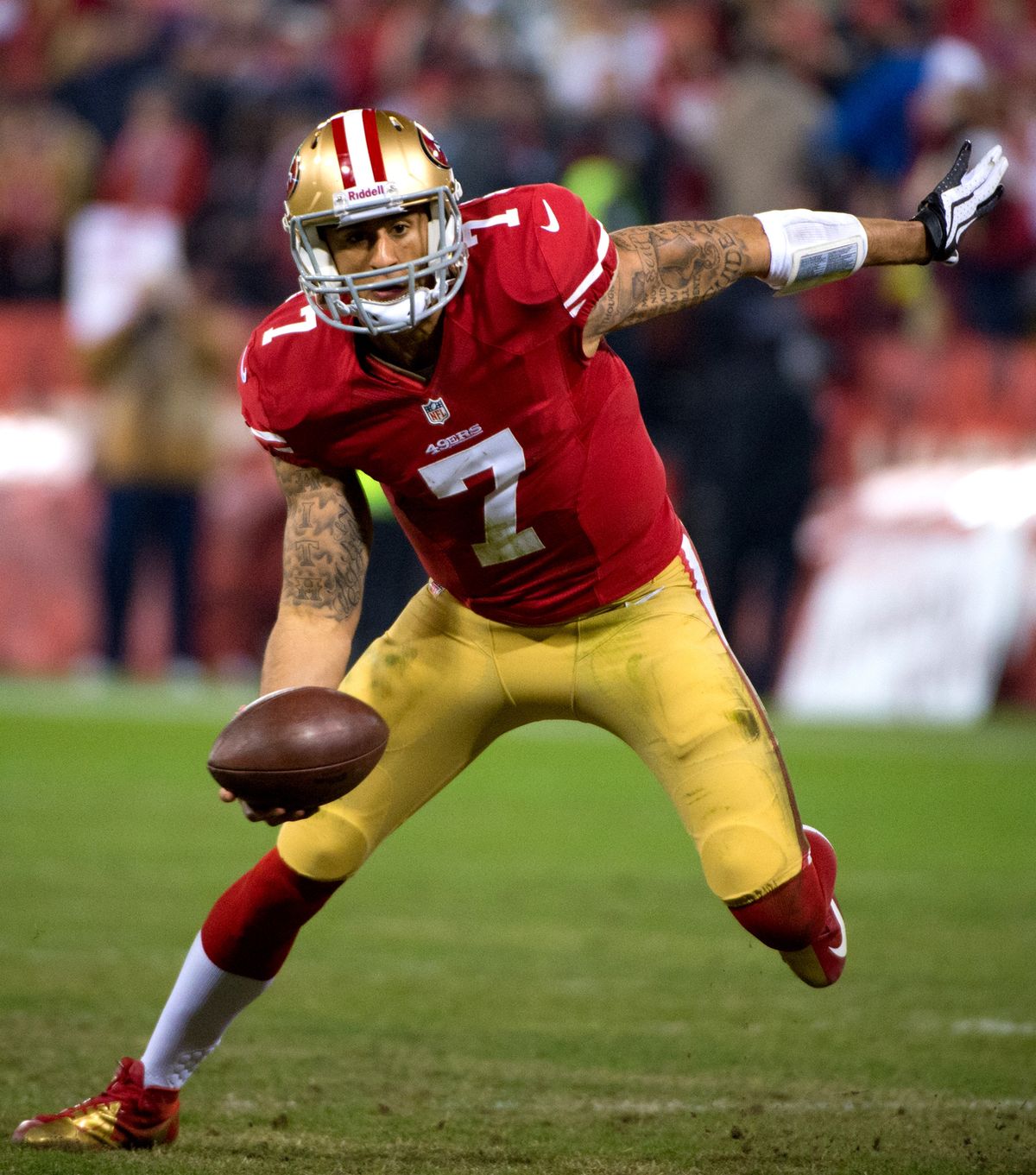Kaepernick’s ink helps express his views on life

To understand the sizable chip on Colin Kaepernick’s right throwing shoulder, it helps to examine it closely – along with every other last inch of his torso.
The Bible verses and artwork that adorn much of the 49ers quarterback’s upper half talk about being respected, taking on enemies without fear, letting God be the guide against doubters.
Some people document their lives through social media. Kaepernick, the NFL’s most sudden rising star, has taken the more painful and artistic path to self-expression. That he’s drawing attention for his tattoos – he has far more than the average NFL quarterback – as well as his sprinter’s legs and rifle arm, does not bother him.
“I got them for me and this is to show people this is what I believe in,” he said Thursday, as the 49ers prepared for next week’s Super Bowl in New Orleans.
Kaepernick, 25, got his initial tattoo in Reno as a sophomore at the University of Nevada. He chose an interpretation from Psalm 27:3 for his left triceps. The verse describes facing enemies without fear and having confidence in God at a time of war.
“That is who he is as a person,” childhood friend Anthony Harding said. “I don’t think any other scripture could say it better than that.
But what provides insight into the psyche of the 6-foot-4 running and throwing sensation is the billboard lettering across his chest: “Against All Odds.”
Kaepernick’s almost fanatical drive for success can be found in episodes throughout his life: He barely was recruited out of high school in Turlock, Calif., and then was the sixth quarterback taken in the 2011 NFL draft. It even dates to early childhood when Kaepernick was so sickly his parents had him tested twice for cystic fibrosis.
“It was like he grew up on antibiotics,” father Rick Kaepernick said. “I’ve never seen a kid have more ear infections.”
The child outgrew the problems while developing into a three-sport star at Pitman High School. But he received a football scholarship offer only from Nevada. Cal and San Jose State were two of the 100 schools that passed.
Many coaches expected Kaepernick to take his 90 mph fastball to professional baseball even though the scholar-athlete swore his allegiance to football. Their lack of trust frosted him.
At Reno he became the first player in NCAA history to throw for more than 10,000 yards and run for more than 4,000.
Kaepernick stuck with the Book of Psalms for his second tattoo in 2008. He got one with words to Psalm 18:39 for his right arm. The verse says, “You armed me with strength for battle; you made my adversaries bow at my feet.”
After that Kaepernick had Reno artist Nes Andrion tattoo two hands clasped in prayer with the words “to God the glory” below the psalm on his right biceps.
This is one of the tattoos – the other reads “Faith” – that Kaepernick kisses in a celebration that has become known as “Kaepernicking.”
“Number one, it’s my way of saying I don’t really care what people think about my tattoos,” he said of the gesture. “God has brought me this far. He has laid out a phenomenal path for me. And I can’t do anything but thank him.”
Then there is Kaepernick’s fully inked back. The large mosaic highlights the opposing forces of good vs. evil as depicted through angels and demons. It expresses the emotional tug-of-war of life on and off the football field.
Andrion worked on the intricate design for 16 hours over one weekend last summer at his Stain Tattoo shop. The experience represented what Andrion likes most about his famous client.
“He can sit there and take it – just like life,” the artist said.
The quarterback seemed more in the Super Bowl moment Thursday when asked to describe his favorite tattoo, “My Gift is My Curse.”
“Being an NFL quarterback there’s a lot of advantages that come with it,” he said. “There are a lot of doors that open when you’re a quarterback but at the same time there’s a lot of scrutiny. There are a lot of things you can’t do as well.”
Rick and Teresa Kaepernick didn’t encourage their son to get a tattoo when he broached the subject five years ago. After Kaepernick showed them artwork with the psalm, his mom relented. “Well at least it is religious,” she said.
Some friends wondered why Rick Kaepernick, a vice president of Hilmar Cheese near Modesto, would pay for his son’s tattoos. The father explained it was Colin who footed the bills.
“He’s kind of like a little miser,” Rick said. “He never spent any of the money we gave him for Christmas or his birthday. It always went into the bank.”
The visible nature of Kaepernick’s tattoos have raised a few eyebrows. In November, a Sporting News columnist equated Kaepernick’s ink work with prison culture, setting off a firestorm of commentary on social media. The family felt the comparison was shallow and unfair, and felt compelled to say so.
“You are categorizing this kid on something like tattoos? Really?” Teresa Kaepernick told USA Today.
David J. Leonard, a professor of critical culture, gender and race studies at Washington State, said many people misconstrue this form of messaging.
“Tattoos provide something a little more than skin deep,” he said. “It’s a push back to the way society often boxes people in because of race, gender, sexuality.”
Kaepernick has used the recent attention to launch a small clothing venture with Orly Locquiao, owner of Cukui in San Jose’s Japantown neighborhood.
They are selling T-shirts with representations of some of Kaepernick’s tattoos as well as his No. 7 jersey. Customers lined up for 2 1/2 hours to buy $32 shirts the day before the 49ers defeated the Atlanta Falcons in the NFC Championship game.